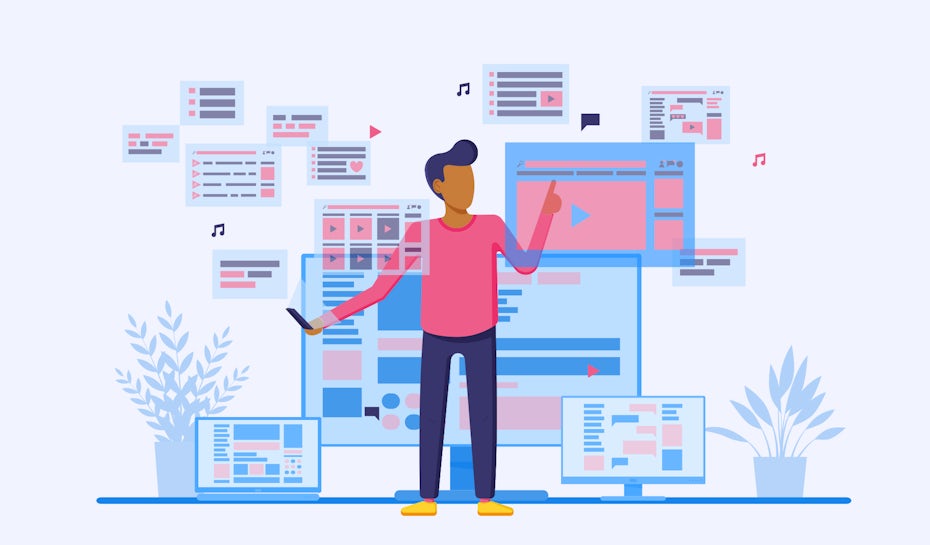Learn how web development powers better usability and user satisfaction
Uncovering the Uses of Website Design for Enhancing Individual Experience
Website design considerably influences user experience across electronic systems. By focusing on user requirements, developers create web sites that are not just visually appealing yet accessible and likewise practical. Trick components such as receptive design and user-friendly navigating play vital roles in improving use. Nonetheless, the challenge hinges on comprehending just how these elements engage to fulfill evolving user expectations. The expedition of these elements reveals insights that could change electronic involvement.
Recognizing Individual Requirements and Expectations
How can Web developers properly straighten their developments with individual demands and assumptions? To attain this, designers need to engage in extensive individual research study to record the preferences, behaviors, and discomfort factors of their target market. Using techniques such as surveys, meetings, and usability screening, developers gather important understandings that guide their decision-making process.
Creating customer characters can further help in visualizing different customer sectors, guaranteeing that design choices reverberate with actual users. Furthermore, designers need to focus on user-friendly navigating and clear contact us to activity, which facilitate seamless communications.
The Importance of Responsive Layout
As individuals significantly accessibility sites on a range of tools, receptive design has come to be crucial for producing a favorable customer experience. This method enables Web pages to adjust perfectly to different screen dimensions, ensuring that content is quickly readable and navigable, despite whether an individual is on a tablet, mobile phone, or desktop computer .
Receptive layout enhances usability by offering a constant experience, decreasing the demand for extreme scrolling or zooming. Additionally, search engines favor receptive web sites, which can enhance a site's exposure and reach. This layout technique likewise improves advancement efforts, as it eliminates the demand for several versions of a site customized to details tools.
Including receptive style not only meets individual assumptions yet additionally aligns with contemporary Web standards, promoting interaction and satisfaction. Inevitably, it indicates a dedication to availability and inclusivity, critical components for any kind of successful online visibility.
Producing Intuitive Navigating
A reliable website design not only encompasses receptive formats however likewise prioritizes intuitive navigating, which is crucial for directing individuals through a site perfectly. Intuitive navigating warranties that individuals can easily find info without unneeded effort. Secret components consist of a clear food selection structure, sensible classification of material, and well-known icons or tags.
Consistency in navigation positioning throughout different pages cultivates knowledge, enhancing individual convenience. Utilizing breadcrumb routes allows users to track their place within the website, aiding in backtracking and expedition. Furthermore, optimizing navigating for smart phones is basic, as numerous customers accessibility internet sites by means of mobile phones and tablets.
Including a search bar can furthermore streamline the individual experience, enabling fast access to certain content. Generally, intuitive navigating minimizes stress, encourages longer site sees, and inevitably brings about greater user fulfillment and engagement. By focusing on navigation style, Web developers can substantially enhance the overall customer experience.
Utilizing Aesthetic Pecking Order Successfully
Reliable website design depends upon the tactical use aesthetic pecking order, making sure that individuals can effortlessly navigate content and realize one of the most vital details at a look. By focusing on components based upon their significance, developers can direct customers' interest toward crucial areas, such as headlines, calls-to-action, and essential images.
Strategies such as dimension, color, contrast, and positioning play essential duties in establishing this pecking order. For example, bigger text commonly signifies higher relevance, while contrasting colors can accentuate essential actions. Furthermore, consistent alignment and spacing aid produce an arranged design, making it easier for individuals to process info quickly.
In addition, integrating imagery tactically can enhance understanding and retention of web content. When used properly, a distinct aesthetic power structure not just improves usability but likewise improves the overall individual experience, permitting individuals to involve meaningfully with the site's purposes.
Enhancing Readability and Ease Of Access
Aesthetic power structure greatly impacts exactly how individuals interact with a website, yet similarly important is assuring that content remains understandable and available to all target markets. Efficient website design uses clear typography, including appropriate font style dimensions, line spacing, and contrast to enhance readability. Using high-contrast color design can aid those with aesthetic problems, while bigger message dimensions profit users with reading troubles. In addition, including alt message for photos warranties that people making use of display viewers can access essential info.
Developers must also think about the design and structure of content, utilizing headings and bullet points to break up huge blocks of text. This not just aids skimming but likewise aids individuals with cognitive handicaps. Ultimately, focusing on readability and access promotes a comprehensive atmosphere, permitting diverse audiences to involve completely with the web site's material (branding). By attending to these aspects, Web designers can significantly enhance the general individual experience
Including Involving Visual Elements
Including engaging visual components is essential for enhancing user experience in Web layout. Shade psychology plays a considerable role in influencing users' emotions and habits, while interactive graphics can record attention and urge expedition. Together, these elements create a much more appealing and dynamic online atmosphere.
Significance of Shade Psychology
The importance of shade psychology in website design can not be overemphasized, as it plays a crucial duty in shaping customer understandings and habits. Colors evoke emotions and can affect how individuals connect with a site. For example, blue commonly communicates count on and professionalism and trust, making it a preferred choice for financial institutions. Alternatively, red can cause necessity and exhilaration, often used in sales promos. Understanding the mental impacts of color allows developers to develop a cohesive visual experience that resonates with customers. In addition, consistent color design enhance brand identity and acknowledgment, making sure individuals associate certain colors with particular brands. Eventually, thoughtful application of shade psychology can greatly improve user engagement and contentment, making it a basic facet of reliable Web layout.
Making Use Of Interactive Graphics
Involving customers via interactive graphics can greatly Check This Out enhance their total experience on a web site. These elements, such as computer animations, infographics, and clickable visuals, foster a much deeper link between customers and the web content. By urging expedition and participation, interactive graphics can make complicated information extra digestible and preserve users' attention much longer. Furthermore, they provide an opportunity for users to interact with the site in a meaningful method, causing enhanced satisfaction and a higher likelihood of returning. However, it is necessary to balance interactivity with usability; extremely complicated graphics may perplex users. Effectively applied, interactive graphics can change a passive watching experience right into an appealing trip, eventually adding to enhanced customer experience and site performance.
Constant Examining and Enhancement Approaches
Constant testing and renovation techniques act as vital components in optimizing website design for user experience. By executing iterative testing, designers can gather real-time feedback on individual communications, enabling them to identify discomfort points and areas for improvement - website design. A/B screening, usability testing, and warm mapping are effective techniques that provide understandings into customer behavior, enabling enlightened design choices
These methods urge a society of recurring refinement, instead than an one-time launch. Web developers can use analytics tools to keep track of efficiency metrics, such as bounce rates and conversion prices, which assist necessary changes. Normal updates based upon individual feedback not only boost capability however likewise foster individual have a peek at these guys complete satisfaction and loyalty.
Eventually, continuous testing and improvement develop a receptive Web layout setting where user experience is prioritized, making look these up sure that the website advances together with user demands and technological developments. This proactive approach leads to a much more effective and appealing on-line existence.
Regularly Asked Concerns
Just How Can Shade Psychology Impact Individual Experience in Web Layout?
Shade psychology greatly affects user experience in website design by guiding and stimulating feelings actions. Different colors can create associations, improve readability, and impact user interaction, inevitably shaping perceptions of a brand name or website's performance.
What Duty Does Typography Play in User Interaction?
Typography considerably influences customer interaction by improving readability, establishing pecking order, and communicating brand name personality. Efficient font options can record interest, stimulate emotions, and overview users with web content, eventually improving overall communication and complete satisfaction with the site.

How Do Cultural Differences Impact Web Design Preferences?
Social distinctions considerably influence website design choices, impacting color selections, images, design, and navigating styles. Recognizing these variations allows designers to create more appealing and relatable experiences tailored to diverse user backgrounds and assumptions.

What Tools Can Assist Test User Experience Properly?
Numerous tools, including Google Analytics, Hotjar, and UsabilityHub, effectively examination user experience. These platforms provide insights right into user habits, help with A/B screening, and gather responses, assisting designers make educated decisions to boost general functionality.
Exactly how Usually Should a Website Be Redesigned for Optimum Customer Experience?
A website ought to be revamped every two to three years to preserve excellent individual experience. Routine updates ensure the style remains modern, receptive, and aligned with progressing user needs and technical developments, improving general engagement.
Developing customer identities can further aid in picturing different individual sections, making certain that style choices resonate with real users. As individuals significantly gain access to internet sites on a selection of tools, receptive design has actually become crucial for producing a favorable user experience. Incorporating interesting visual elements is necessary for boosting customer experience in Web design. Ultimately, continuous testing and improvement create a responsive Web design atmosphere where customer experience is prioritized, ensuring that the site evolves together with individual demands and technical innovations. Shade psychology considerably influences user experience in Web style by evoking emotions and leading actions.